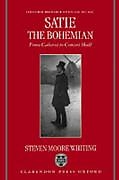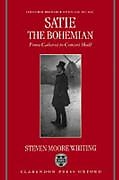Satie the Bohemian
Einband:
Fester Einband
EAN:
9780198164586
Autor:
Stephen Moore Whiting
Herausgeber:
OUP Oxford
Erscheinungsdatum:
01.07.1998
Zusatztext One by one! illuminated in the clear light of professor Whiting's brilliant scholarship! there emerge the shadowy figures who influenced Satie during the 20-odd years he spent as a pub pianist in the smoke-filled bars of Montmartre. Whiting elaborates his thesis with a magnificent displayof erudition conveyed in lucid! elegant prose. This is a splendid book! valuable to anyone interested in French popular culture. - James Harding! BBC Music - August 1999 Klappentext The composer Erik Satie (1866-1925) came of age in the bohemian sub-culture of Montmartre, with its artists' cabarets and cafes-concerts. These colorful milieux decisively shaped his aesthetic priorities and compositional strategies, from the esoteric Gymnopedies of the 1880s to the avant-garde ballets of the 1920s. Whiting makes this radical transvaluation of received artistic values more understandable by placing it in the full context of bohemian Montmartre. Zusammenfassung Apologists have often tried to play down Erik Satie's connection to the bohemian subculture of Montmartre. In this book Whiting argues that far from harming his reputation, this connection decisively shaped his aesthetic priorities and compositional strategies. Inhaltsverzeichnis Introduction Part I: Café-Concert, Music-Hall, Cabaret 1: The Café-Concert 2: From Caf'Conç' to Music-Hall 3: The Cabaret Artistique Part II: Satie's Involvement in Popular Milieux 4: Satie at the Chat Noir 5: Satie and the Divan Japonais 6: Satie at the Auberge du Clou 7: From the Auberge du Clou to Arcueil 8: Satie and Hyspa 9: Of Pantomimes and Pears 10: Waltz, Cakewalk, Theatre Song Part III: From Cabaret to Concert Hall 11: Satie's Humouristic Works for Piano 12: From Chanson to Mélodie and Back 13: The Composer as Playwright 14: Autour de Cocteau, or The Uses of Popular Music 15: On revient toujours: Satie's Last Ballets List of Sources Cited Index ...
Klappentext
The composer Erik Satie (1866-1925) came of age in the bohemian sub-culture of Montmartre, with its artists' cabarets and cafes-concerts. These colorful milieux decisively shaped his aesthetic priorities and compositional strategies, from the esoteric Gymnopedies of the 1880s to the avant-garde ballets of the 1920s. Whiting makes this radical transvaluation of received artistic values more understandable by placing it in the full context of bohemian Montmartre.
Zusammenfassung
Apologists have often tried to play down Erik Satie's connection to the bohemian subculture of Montmartre. In this book Whiting argues that far from harming his reputation, this connection decisively shaped his aesthetic priorities and compositional strategies.
Inhalt
Introduction
Part I: Café-Concert, Music-Hall, Cabaret
1: The Café-Concert
2: From Caf'Conç' to Music-Hall
3: The Cabaret Artistique
Part II: Satie's Involvement in Popular Milieux
4: Satie at the Chat Noir
5: Satie and the Divan Japonais
6: Satie at the Auberge du Clou
7: From the Auberge du Clou to Arcueil
8: Satie and Hyspa
9: Of Pantomimes and Pears
10: Waltz, Cakewalk, Theatre Song
Part III: From Cabaret to Concert Hall
11: Satie's Humouristic Works for Piano
12: From Chanson to Mélodie and Back
13: The Composer as Playwright
14: Autour de Cocteau, or The Uses of Popular Music
15: On revient toujours: Satie's Last Ballets
List of Sources Cited
Index

Leider konnten wir für diesen Artikel keine Preise ermitteln ...
billigbuch.ch sucht jetzt für Sie die besten Angebote ...
Die aktuellen Verkaufspreise von 6 Onlineshops werden in Realtime abgefragt.
Sie können das gewünschte Produkt anschliessend direkt beim Anbieter Ihrer Wahl bestellen.
Loading...
Die aktuellen Verkaufspreise von 6 Onlineshops werden in Realtime abgefragt.
Sie können das gewünschte Produkt anschliessend direkt beim Anbieter Ihrer Wahl bestellen.
| # | Onlineshop | Preis CHF | Versand CHF | Total CHF | ||
|---|---|---|---|---|---|---|
| 1 | Seller | 0.00 | 0.00 | 0.00 |
